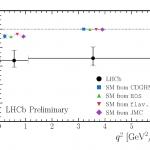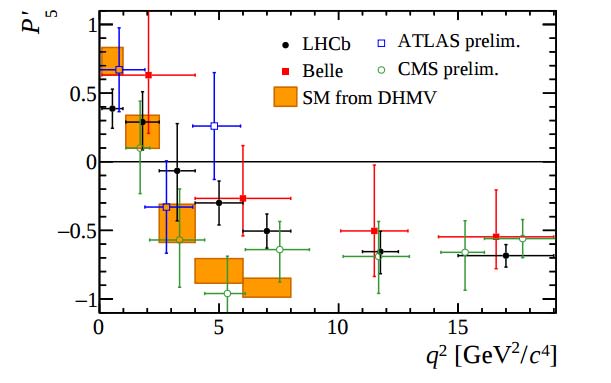Paper of the month: On the LHCb flavour anomalies

May 22, 2017 by tiinatimonen
The goal is to test the universality of lepton interactions. The muon is 200 times heavier than the electron, but in the Standard Model its interactions are otherwise identical to those of the electron, a property known as lepton universality, which means that we should have RK∗ = 1 for an invariant mass q2 (4mµ)2: no difference between muon and electron channels, i.e., electron and muons should be produced with the same probability in this specific B0 decay.
LHCb finds instead that the decays involving muons occur less often. The experimental results deviate 2.4σ from the SM (figure 1a), which could easily be a merely statistical fluctuation. Nevertheless, the interesting point is that this observation points in the same direction of other previous observations, some of which are, however, affected by large theoretical uncertainties: 1. RK, which is defined as RK∗ but with B+ instead of B (and consequently K+ instead of K∗ 2. Branching ratios of B → K∗µ+µ−, Bs → φµ+µ− 3.
Angular distributions in the semi-leptonic decay B → K∗µ+µ− For the observables in points 2 and 3 the main source of uncertainty resides in the proper evaluation of the form factors and in the estimates of the non-factorizable hadronic corrections. The LHCb can perform a full angular analysis of the decay products B → K∗µ+µ−, and it is possible to construct observables with limited sensitivity to form-factors, i.e. where the theoretical uncertainties will cancel out.
One of these observables is P0 5, which depends on the longitudinal polarization of the K∗ meson and on a bilinear combination of the K∗ meson transition amplitudes. Besides LHCb, also ATLAS, CMS, and BELLE experiments have data analyses pointing to the same direction. From figure 1b, it is possible to notice a tension between the measurements of the observable P0 5 and its corresponding Standard Model prediction. In the region 4 < q2 < 8GeV2 the data from LHCb, ATLAS and BELLE are clearly above the Standard Model predictions, while CMS measurements are more consistent.
From the theoretical point of view, if indeed this is a sign of New Physics, the hypotheses to explain it are wide and very interesting.
Several classes of models attempt to explain simultaneously these anomalies with other tension on the flavour data, e.g. the long-standing anomaly in the magnetic moment of the muon. Typically new kind of particles, like a new boson Z’ or leptoquarks, are introduced to mediate the relevant interactions at tree level and to generate new operators. Also models of composite Higgs could be a potential source of New Physics in the flavour sector. A review of some of these possible solutions can be found in [3].
References
[1] R. Aaij et al., arXiv:1705.05802[hep-ph].
[2] T. Blake, M. Gersabeck, L. Hofer, S. Jger, Z. Liu, and R. Zwicky, Proceedings, 12th Conference on Quark Confinement and the Hadron Spectrum (Confinement XII): Thessaloniki, Greece, EPJ Web Conf. 137, 01001 (2017), arXiv:1703.10005 [hep-ph]
(a)
.jpg)
(b)

Figure 1: (a) RK∗ results measured by LHCb, comparared with the SM prediction, as a function of the dimuon invariant mass squared, q2 [1]. (b) P0 5 measured by different experiments, as a function of the dimuon invariant mass squared q2, in the decay B → K∗ µ+ µ− [2].
[3] G. D’Amico, M. Nardecchia, P. Panci, F. Sannino, A. Strumia, R. Torre and A. Urbano, arXiv:1704.05438 [hep-ph].


